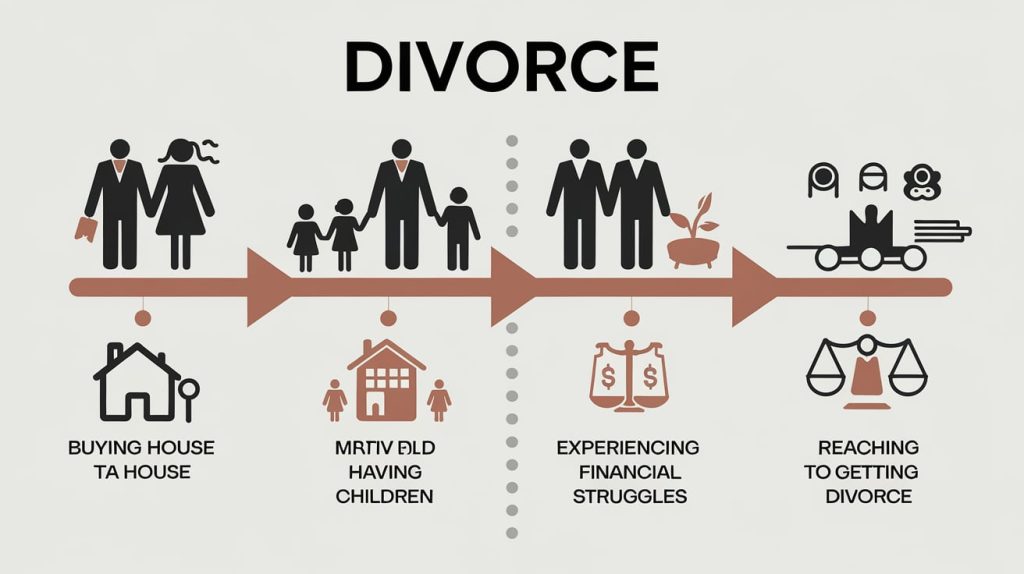Divorce is a significant legal and emotional process that requires understanding the timeline and steps involved. Each state in the United States has specific laws and procedures, but this guide provides a general overview of the divorce timeline with case studies and legal references to help you navigate the process effectively.
Understanding the Divorce Timeline
The divorce timeline varies depending on factors like state laws, complexity of the case, and cooperation between spouses. Below is a detailed breakdown of the key stages:
1. Filing the Divorce Petition (1–2 Weeks)
The divorce process begins when one spouse (the petitioner) files a divorce petition in the appropriate state court.
- What’s Included?: Details of the marriage, grounds for divorce, and requested relief (custody, alimony, etc.).
- Legal Reference: Check your state’s family law statutes, such as California Family Code § 2310.
Case Study Example:
In Boddie v. Connecticut (401 U.S. 371), the U.S. Supreme Court ruled that access to divorce proceedings is a fundamental right, emphasizing the importance of due process.
2. Serving Divorce Papers (2–4 Weeks)
The petitioner must serve divorce papers to the other spouse (respondent). Service of process ensures the respondent is notified and has the opportunity to respond.
- Methods of Service: Personal delivery, certified mail, or through a process server.
- Legal Reference: Federal Rule of Civil Procedure 4.
3. Response from the Other Spouse (1–2 Months)
The respondent typically has 20–30 days (depending on the state) to respond to the petition. They can either:
- Agree to the terms (uncontested divorce).
- Dispute the claims (contested divorce).
Case Law Insight:
In Kulko v. Superior Court (436 U.S. 84), the court addressed jurisdiction issues in divorce cases, reinforcing that responses must align with state and federal rules.
4. Temporary Orders and Mediation (2–6 Months)
If immediate decisions are needed (e.g., custody, child support), the court may issue temporary orders during the divorce proceedings.
- Mediation: Many states require mediation to resolve disputes without trial.
- Legal Reference: Uniform Mediation Act.
5. Discovery Process (3–6 Months)
Discovery involves gathering evidence about assets, income, debts, and other relevant issues.
- Methods: Interrogatories, subpoenas, depositions, and document requests.
Case Study Example:
In Rosen v. Rosen (696 So. 2d 697), transparency during discovery was pivotal in determining equitable asset distribution.
6. Negotiation and Settlement (1–3 Months)
If both parties agree on key issues, they can reach a settlement without going to trial. Settlement agreements outline the terms of divorce, including property division, custody, and spousal support.
- Benefit: Saves time and legal fees compared to a court trial.
7. Trial (If Required) (6–12 Months)
For contested divorces, unresolved disputes are addressed in court. A judge reviews evidence and testimonies to make decisions.
- Legal Reference: Most states follow equitable distribution principles, as highlighted in Ferguson v. Ferguson (639 So. 2d 921).
8. Final Judgment and Waiting Period (2–6 Months)
Once the trial concludes or the settlement is approved, the court issues a final judgment of divorce. Some states require a waiting period before the divorce is finalized.
- Example: In Maryland, there is a 30-day waiting period after the judgment.
Factors Affecting the Timeline
- State Laws: Some states, like Nevada, have shorter timelines for no-fault divorces.
- Contested vs. Uncontested Divorce: Contested cases take significantly longer.
- Child Custody Disputes: Cases involving custody and support may extend the timeline.
Key Takeaways and Legal Insights
- Plan Ahead: Understanding the divorce timeline helps manage expectations.
- Hire an Attorney: Legal representation ensures compliance with state laws.
- Stay Informed: Refer to state statutes and case laws for detailed guidance.
For more legal resources, visit the Legal Information Institute or consult with a family law attorney in your state.
Navigating a divorce can be challenging, but understanding the timeline empowers you to make informed decisions. Have questions or insights to share? Leave a comment below!

